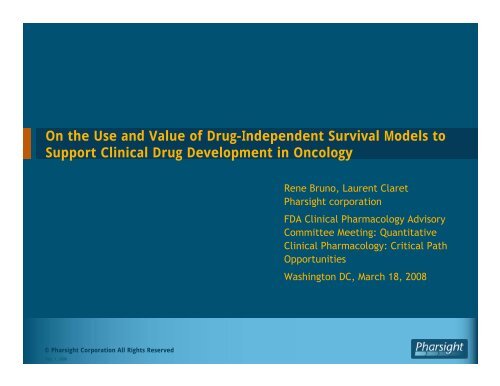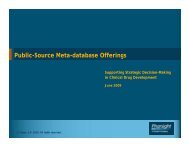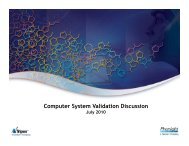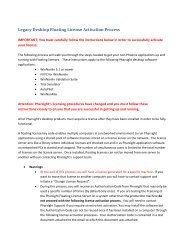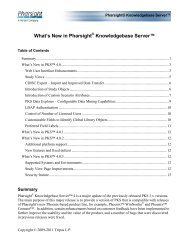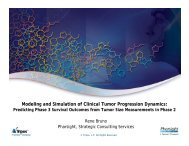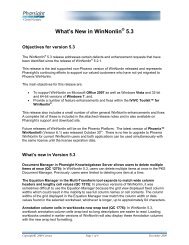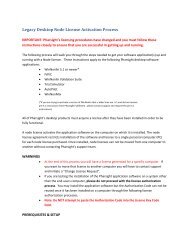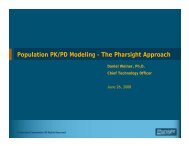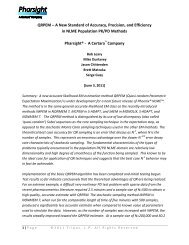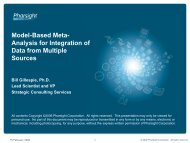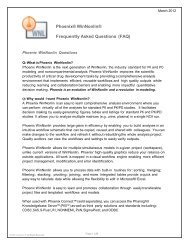On the Use and Value of Drug-Independent Survival Models to ...
On the Use and Value of Drug-Independent Survival Models to ...
On the Use and Value of Drug-Independent Survival Models to ...
Create successful ePaper yourself
Turn your PDF publications into a flip-book with our unique Google optimized e-Paper software.
<strong>On</strong> <strong>the</strong> <strong>Use</strong> <strong>and</strong> <strong>Value</strong> <strong>of</strong> <strong>Drug</strong>-<strong>Independent</strong> <strong>Survival</strong> <strong>Models</strong> <strong>to</strong><br />
Support Clinical <strong>Drug</strong> Development in <strong>On</strong>cology<br />
Rene Bruno, Laurent Claret<br />
Pharsight corporation<br />
FDA Clinical Pharmacology Advisory<br />
Committee Meeting: Quantitative<br />
Clinical Pharmacology: Critical Path<br />
Opportunities<br />
Washing<strong>to</strong>n DC, March 18, 2008<br />
© Pharsight Corporation All Rights Reserved<br />
Feb. 1, 2008
Outline<br />
<strong>Drug</strong> development in oncology<br />
A drug-disease modeling framework <strong>to</strong> support drug development<br />
in <strong>On</strong>cology<br />
● Tumor growth model<br />
● <strong>Survival</strong> model<br />
Support <strong>to</strong> end-<strong>of</strong>-Phase II development decisions: A retrospective<br />
project with capecitabine (Roche)<br />
<strong>On</strong> <strong>the</strong> use <strong>the</strong> FDA NSCLC survival model<br />
● A case study based on erlotinib data<br />
<strong>Value</strong> <strong>of</strong> <strong>the</strong> survival simulations<br />
Conclusions<br />
slide 2<br />
March, 2008<br />
© Pharsight Corporation All Rights Reserved
<strong>Drug</strong> development in oncology<br />
Lots <strong>of</strong> new drug c<strong>and</strong>idates with new mechanisms <strong>of</strong> action<br />
● Major advances in underst<strong>and</strong>ing <strong>the</strong> molecular biology <strong>and</strong> genetics <strong>of</strong><br />
<strong>the</strong> disease have led <strong>to</strong> <strong>the</strong> so-called “targeted <strong>the</strong>rapies”<br />
● Highly competitive market<br />
Empirical selection <strong>of</strong> dose <strong>and</strong> dosing schedules<br />
● MTD vs. biologically active dose paradigm in Phase I<br />
● Phase II studies not designed <strong>to</strong> assess dose-response<br />
• Typical r<strong>and</strong>omized Phase IIb dose-ranging studies are not conducted in<br />
oncology<br />
● Analysis <strong>of</strong> clinical trial data poorly informative (e.g. response rate,<br />
neutropenia grade…)<br />
Limit <strong>the</strong> ability <strong>to</strong> learn from early clinical trials<br />
High failure rate in Phase III<br />
slide 3<br />
March, 2008<br />
© Pharsight Corporation All Rights Reserved
A drug-disease disease modeling framework <strong>to</strong> predict clinical<br />
endpoints <strong>and</strong> support oncology drug development<br />
Dose-reductions<br />
DLT<br />
Biomarkers<br />
ORR<br />
Dose<br />
Exposure<br />
Tumor size<br />
dynamics<br />
PFS<br />
PK / MOA / Resistance<br />
covariates, prognostic fac<strong>to</strong>rs,<br />
gene expression, protein<br />
pr<strong>of</strong>ile<br />
<strong>Survival</strong><br />
<strong>Models</strong> / Endpoints<br />
slide 4<br />
March, 2008<br />
© Pharsight Corporation All Rights Reserved
The exposure - tumor size – survival model: A bridge from<br />
Phase II <strong>to</strong> Phase III endpoints<br />
Phase 2 Phase 3<br />
Tumor size<br />
Dose Exposure <strong>Survival</strong><br />
dynamics<br />
<strong>Drug</strong> specific<br />
Disease/Patient<br />
specific<br />
Disease<br />
specific<br />
To predict phase 3 endpoint based on<br />
phase 2 endpoint <strong>and</strong> prognostic fac<strong>to</strong>rs<br />
Claret L et al. Model-based predictions <strong>of</strong> expected anti-tumor response <strong>and</strong> survival in Phase III studies based on<br />
phase II data <strong>of</strong> an investigational agent. Proc ASCO, 24 (18S), 307s (Abs 6025), 2006.<br />
slide 5<br />
March, 2008<br />
© Pharsight Corporation All Rights Reserved
The tumor-size model incorporates tumor growth <strong>and</strong> drug<br />
effect<br />
( )<br />
dy t<br />
dt<br />
R t<br />
()<br />
=<br />
L<br />
t<br />
e −λ<br />
() () () () y( 0)<br />
= K ⋅y t −K ⋅Exposure t ⋅R t ⋅ y t = y<br />
D<br />
y(t): Larger diameter at time t (mm), y(0): baseline tumor size<br />
Exposure(t): Exposure at time t (dose, AUC…))<br />
R(t): Resistance function decreasing with time, ranging from 1 (no<br />
resistance) <strong>to</strong> 0 (no more drug action)<br />
λ: Rate constant <strong>of</strong> resistance appearance<br />
K L : Tumor growth rate<br />
K D : <strong>Drug</strong> constant-cell-kill rate<br />
K D , λ: drug specific<br />
Y 0 , K L : disease/patient specific<br />
0<br />
Claret et al. PAGE 15, (Abstract 1004), 2006 [www.page-meeting.org/?abstract=1004]<br />
slide 6<br />
March, 2008<br />
© Pharsight Corporation All Rights Reserved
Support <strong>to</strong> end-<strong>of</strong><br />
<strong>of</strong>-Phase II development decisions:<br />
A retrospective project with capecitabine (Roche)<br />
Goal: To support early drug development decisions<br />
● Go/No go<br />
● Design <strong>of</strong> Phase III studies<br />
Simulate expected survival difference in Phase III<br />
● Comparing a new drug (X) <strong>to</strong> a reference drug (R)<br />
● Based on Phase II data <strong>of</strong> X <strong>and</strong> his<strong>to</strong>rical data <strong>of</strong> R<br />
Retrospective project:<br />
● To simulate:<br />
• Phase III <strong>of</strong> capecitabine (X) + docetaxel (R) vs. docetaxel in MBC<br />
• Phase III <strong>of</strong> capecitabine (X) vs. 5-Fu (R) in CRC<br />
Claret L et al. Model-based predictions <strong>of</strong> expected anti-tumor response <strong>and</strong> survival in Phase III<br />
studies based on phase II data <strong>of</strong> an investigational agent. Proc ASCO, 24 (18S), 307s (Abs 6025),<br />
2006.<br />
slide 7<br />
March, 2008<br />
© Pharsight Corporation All Rights Reserved
Simulation <strong>of</strong> a Phase III study comparing docetaxel <strong>to</strong><br />
docetaxel + capecitabine in MBC<br />
Model parameter estimation<br />
● Capecitabine data<br />
• Phase II (2 studies, 170 patients)<br />
● Docetaxel data<br />
• Phase III (docetaxel arm, 223 patients)<br />
Simulation<br />
● Phase III study <strong>of</strong> capecitabine + docetaxel vs. docetaxel (443 patients,<br />
1000 replicates)<br />
• Assumes additive effect for <strong>the</strong> combination<br />
• Capecitabine scaled from Phase II <strong>to</strong> Phase III using disease specific<br />
parameters<br />
Focus on efficacy, no model for dose-limiting side-effects<br />
● Simulations conditioned on observed dose intensity (dosing his<strong>to</strong>ry)<br />
● <strong>Drug</strong> effect driven by dose<br />
slide 8<br />
March, 2008<br />
© Pharsight Corporation All Rights Reserved
Simulation <strong>of</strong> tumor size reduction at week 6 vs. observed in<br />
<strong>the</strong> Phase III study (1000 replicates)<br />
Docetaxel + Capecitabine Arm<br />
Number <strong>of</strong> replicates<br />
0 100 200 300<br />
-0.2 0.0 0.2 0.4 0.6<br />
0 100 200 300<br />
-0.2 0.0 0.2 0.4 0.6<br />
0 50 100 200 300<br />
-0.2 0.0 0.2 0.4 0.6<br />
25 th Quantile Median<br />
75 th Quantile<br />
Tumor size reduction relative <strong>to</strong> baseline<br />
Observed Predicted 90% PI<br />
Median 0.210 0.270 ( 0.180 - 0.360 )<br />
slide 9<br />
March, 2008<br />
© Pharsight Corporation All Rights Reserved
Simulation <strong>of</strong> survival vs. observed in <strong>the</strong> Phase III study <strong>of</strong><br />
docetaxel + capecitabine vs. docetaxel<br />
Combination Arm<br />
Docetaxel Arm<br />
<strong>Survival</strong><br />
0.0 0.2 0.4 0.6 0.8 1.0<br />
<strong>Survival</strong><br />
0.0 0.2 0.4 0.6 0.8 1.0<br />
0 200 400 600 800 1000<br />
Days<br />
0 200 400 600 800 1000<br />
Days<br />
slide 10<br />
March, 2008<br />
© Pharsight Corporation All Rights Reserved
Expected survival comparison in a Phase III study <strong>of</strong><br />
docetaxel + capecitabine vs. docetaxel<br />
<strong>Survival</strong><br />
0.0 0.2 0.4 0.6 0.8 1.0<br />
Docetaxel<br />
Combination<br />
Observed Predicted<br />
Combination 431 412 (330-526)<br />
Docetaxel 353 356 (286-443)<br />
Med. Diff 78 57 (-17~148)<br />
0 200 400 600 800 1000<br />
Days<br />
slide 11<br />
March, 2008<br />
© Pharsight Corporation All Rights Reserved
Capecitabine project conclusions<br />
The structure <strong>of</strong> <strong>the</strong> tumor size model was robust <strong>to</strong> predict tumor<br />
growth <strong>and</strong> anti-tumor effect <strong>of</strong>:<br />
● Three cy<strong>to</strong><strong>to</strong>xic drugs in two tumor types<br />
Change in tumor size was a good predic<strong>to</strong>r <strong>of</strong> survival<br />
● Modeling <strong>of</strong> longitudinal tumor size data is much more informative than<br />
response rate determination<br />
● Poor predic<strong>to</strong>r <strong>of</strong> survival (primary endpoint in Phase III)<br />
• Study-level correlations (Buyse Lancet 2000, Shanafelt JCO 2004)<br />
• Even more problematic with new targeted <strong>the</strong>rapies (cy<strong>to</strong>static ra<strong>the</strong>r than<br />
cy<strong>to</strong><strong>to</strong>xic)<br />
The combined tumor size <strong>and</strong> survival models:<br />
● Successfully predicted expected treatment differences<br />
● Is a useful approach <strong>to</strong> support early development decisions:<br />
• Does <strong>the</strong> expected survival benefit <strong>of</strong> <strong>the</strong> new drug warrant fur<strong>the</strong>r<br />
development?<br />
• If yes, which Phase III study need be designed <strong>to</strong> show non-inferiority,<br />
superiority?<br />
slide 12<br />
March, 2008<br />
© Pharsight Corporation All Rights Reserved
Pharsight uses <strong>the</strong> FDA NSCLC model<br />
Availability <strong>of</strong> data <strong>to</strong> develop <strong>the</strong> survival model is problematic in many<br />
companies<br />
The availability <strong>of</strong> generic public-domain models is critical<br />
We used <strong>the</strong> FDA NSCLC model (Wang et al, DIA, 2007) in one <strong>of</strong> our projects<br />
●<br />
Pharsight <strong>Use</strong>s FDA Disease Model <strong>to</strong> Support <strong>On</strong>cology <strong>Drug</strong> Development:<br />
http://media.corporate-ir.net/media_files/irol/12/121504/Release112007.pdf<br />
The company was interested in getting expectations <strong>of</strong> survival for a NCE in<br />
combination<br />
●<br />
●<br />
●<br />
To support decision <strong>to</strong> start a large Phase III study<br />
They had a Phase Ib combination study in NSCLC (less than 30 patients)<br />
• We used <strong>the</strong> FDA model <strong>and</strong> simulated expected survival based on:<br />
◦ Observed tumor shrinkage<br />
◦ Patient’s prognostic fac<strong>to</strong>rs<br />
The Pharmacometry team (Drs. Wang <strong>and</strong> Gobburu) provided us <strong>the</strong> information we<br />
needed<br />
The model will be used in several o<strong>the</strong>r projects soon<br />
slide 13<br />
March, 2008<br />
© Pharsight Corporation All Rights Reserved
A case study <strong>to</strong> illustrate <strong>the</strong> use <strong>of</strong> <strong>the</strong> FDA NSCLC<br />
model with erlotinib data<br />
Tumor shrinkage data are generally not reported in papers<br />
Karrison, Maitl<strong>and</strong>, Stadler <strong>and</strong> Ratain recently proposed <strong>to</strong> use change in<br />
tumor size as <strong>the</strong> primary endpoint in r<strong>and</strong>omized Phase II trials<br />
(J Natl Cancer Inst, 99, 1455-1461, 2007)<br />
●<br />
●<br />
In table 1 <strong>the</strong>y report data for change in tumor size from 4 trials<br />
We used data from <strong>the</strong> pivotal erlotinib trial in 2 nd line patients<br />
(Shepherd et al. New Engl J Med, 353, 123-132)<br />
• 488 patients in <strong>the</strong> erlotinib arm<br />
• ORR: 8.9%<br />
• <strong>Survival</strong>: 6.7 months<br />
slide 14<br />
March, 2008<br />
© Pharsight Corporation All Rights Reserved
A case study <strong>to</strong> illustrate <strong>the</strong> use <strong>of</strong> <strong>the</strong> FDA NSCLC<br />
model with erlotinib data (cont.)<br />
Data used for <strong>the</strong> simulation<br />
●<br />
●<br />
●<br />
Week 8 fractional change data based on Karrison reported log ratio<br />
• The ratio <strong>of</strong> tumor size at week 8 <strong>to</strong> baseline size is normally distributed<br />
• Log ratio was sampled from normal distribution (Table 1): Mean 0.048, SD: 0.340<br />
• Shrinkage = exp(logratio)-1 (distribution given in backup)<br />
Baseline tumor size distribution<br />
• Sampled from lognormal distribution<br />
• Mean: 100 mm, SD: 57 mm (distribution in backup)<br />
EGOG 0, 1 proportion (80/20%) based on observed in Shepherd<br />
• Shepherd trial included 66 % ECOG 0, 1 <strong>and</strong> 34 % ECOG 2, 3 patients (Table 1)<br />
• Among ECOG 0, 1 patients, 20% had ECOG 1 <strong>and</strong> 80% ECOG 2<br />
We simulated 1000 replicates <strong>of</strong> a virtual treatment arm <strong>of</strong> 300 patients<br />
(second–line, ECOG 0 or 1)<br />
● C <strong>and</strong> D models (assumed <strong>to</strong> be second line treatments) were used <strong>to</strong> simulate 1000<br />
replicates<br />
●<br />
• 25% <strong>of</strong> <strong>the</strong> replicates with C1, C2, D1 <strong>and</strong> D2<br />
• Parameters for each <strong>of</strong> <strong>the</strong> replicates were sampled in uncertainty <strong>of</strong> estimates<br />
Adjusted with early dropouts<br />
slide 15<br />
March, 2008<br />
© Pharsight Corporation All Rights Reserved
The FDA SSCLC model can be used <strong>to</strong> simulate expected<br />
survival based on tumor shrinkage data<br />
Expected median survival: 7.2 months (95% PI: 5.2 <strong>to</strong> 10.1 months)<br />
●<br />
●<br />
Slightly longer than in Shepherd (was 6.7 months)<br />
But only concerns ECOG 0, 1 patients<br />
Proportion<br />
0.0 0.2 0.4 0.6 0.8 1.0<br />
1000 replicates <strong>of</strong> 300 patients<br />
Median 95% prediction interval<br />
0 10 20 30 40<br />
Time (month)<br />
slide 16<br />
March, 2008<br />
© Pharsight Corporation All Rights Reserved
<strong>Value</strong> <strong>of</strong> <strong>the</strong> survival simulations<br />
The survival probability distribution <strong>of</strong> an investigational treatment can be<br />
quantified based on early tumor shrinkage clinical data (typically available in<br />
Phase Ib or II)<br />
●<br />
●<br />
Can be a new NCE<br />
Can be a new combination treatment<br />
An arm <strong>of</strong> <strong>the</strong> investigational treatment can be simulated conditional on a<br />
sample size<br />
●<br />
To mimic a clinical trial arm<br />
These simulations can be compared <strong>to</strong> a survival distribution from a<br />
reference treatment<br />
●<br />
Expected treatment arm difference can support<br />
• Go/no go decision<br />
• Phase III clinical trial design<br />
Phase III clinical trials can be simulated <strong>to</strong> assess probability <strong>of</strong> success<br />
slide 17<br />
March, 2008<br />
© Pharsight Corporation All Rights Reserved
Conclusions<br />
Change in tumor size is a good predic<strong>to</strong>r <strong>of</strong> survival<br />
●<br />
●<br />
●<br />
Response rate (<strong>the</strong> primary endpoint in Phase II) is a poor predic<strong>to</strong>r <strong>of</strong> survival<br />
• Study-level correlations (Buyse Lancet 2000, Shanafelt JCO 2004)<br />
Modeling <strong>of</strong> longitudinal tumor size data is much more informative than response<br />
rate determination <strong>to</strong> predict clinical benefit<br />
Supports use <strong>of</strong> change in tumor size as a primary endpoint in Phase II studies<br />
<strong>Drug</strong>-independent survival models allow <strong>to</strong> predict survival expectations<br />
or simulate Phase III trials based on early Phase Ib or Phase II data<br />
●<br />
●<br />
●<br />
Availability <strong>of</strong> <strong>the</strong>se models is limited<br />
FDA is in a unique position <strong>to</strong> develop such models without disclosing proprietary<br />
information<br />
<strong>Models</strong> for o<strong>the</strong>r endpoints (e.g. PFS) might be needed<br />
A modeling framework combining longitudinal tumor size models <strong>and</strong> drug<br />
independent survival models can be used<br />
●<br />
●<br />
●<br />
To predict expected treatment efficacy (ORR, <strong>Survival</strong>, PFS)<br />
To simulate clinical trials<br />
To support<br />
• <strong>Drug</strong> development decisions<br />
• Clinical trial design<br />
• <strong>Drug</strong> registration<br />
slide 18<br />
March, 2008<br />
© Pharsight Corporation All Rights Reserved
Acknowledgements<br />
Contribu<strong>to</strong>rs <strong>to</strong> <strong>the</strong> Roche project<br />
●<br />
●<br />
●<br />
●<br />
●<br />
P. Girard, Pharsight corporation, now with INSERM, University <strong>of</strong> Lyon,<br />
France<br />
K. Zuideveld, K. Jorga, J. Fagerberg, F. Sirzen, M. Abt, F. H<strong>of</strong>fmann-La<br />
Roche J. O’Shaughnessy, Baylor-Sammons Cancer Center<br />
P. H<strong>of</strong>f, MD Anderson Cancer Center<br />
E. Van Cutsem, University Hospital Gasthuisberg<br />
J. Blum, US <strong>On</strong>cology Dallas<br />
FDA pharmacometrics team<br />
●<br />
Y. Wang <strong>and</strong> J. Gobburu<br />
slide 19<br />
March, 2008<br />
© Pharsight Corporation All Rights Reserved
Backups<br />
slide 20<br />
March, 2008<br />
© Pharsight Corporation All Rights Reserved
<strong>On</strong> <strong>the</strong> use <strong>of</strong> <strong>the</strong> FDA NSCLC survival model<br />
The FDA developed 9 models based on 9 arms from 4 large pivotal studies<br />
● 243 <strong>to</strong> 488 patients per arm<br />
● The FDA model assumes a lognormal distribution <strong>of</strong> survival time<br />
● The predic<strong>to</strong>rs are tumor size at baseline, tumor shrinkage at week 8 <strong>and</strong> ECOG<br />
performance status<br />
• 20 <strong>to</strong> 30 % <strong>of</strong> patients were excluded due <strong>to</strong> lack <strong>of</strong> tumor size data (early dropouts)<br />
●<br />
• ECOG 2 <strong>and</strong> 3 patients excluded in arms C <strong>and</strong> D<br />
FDA provided parameter estimates with more digits than in Wang’s DIA presentation<br />
(slide 19) (see table below)<br />
Parameter A1 A2 B1 B2 B3 C1 C2 D1 D2<br />
Intercept 5.9222 5.8341 5.6411 5.6191 5.7617 5.9545 5.8865 5.9982 5.859<br />
SE 0.093 0.071 0.072 0.067 0.067 0.15 0.13 0.13 0.11<br />
Baseline -0.029 -0.028 -0.03 -0.022 -0.037 -0.047 -0.035 -0.02 -0.035<br />
SE 0.0073 0.0079 0.0092 0.007 0.009 0.012 0.01 0.0084 0.0097<br />
ECOG -0.309 -0.2 -0.178 -0.092 -0.37 -0.515 -0.258 -0.431 -0.344<br />
SE 0.084 0.084 0.092 0.085 0.082 0.16 0.14 0.14 0.12<br />
Tumor 0.9376 0.7965 1.3587 1.3124 0.959 0.4766 0.5793 0.2513 0.5252<br />
SE 0.21 0.17 0.2 0.19 0.15 0.2 0.23 0.1 0.14<br />
Scale 0.7174 0.7352 0.7399 0.6683 0.6477 0.6939 0.7987 0.6824 0.6017<br />
SE 0.033 0.033 0.038 0.034 0.032 0.053 0.048 0.046 0.038<br />
slide 21<br />
March, 2008<br />
© Pharsight Corporation All Rights Reserved
The figure on slide 20 <strong>of</strong> <strong>the</strong> DIA presentation was reproduced<br />
<strong>to</strong> validate <strong>the</strong> implementation <strong>of</strong> <strong>the</strong> simulation code<br />
Expected survival time(month)<br />
10 15 20<br />
D1<br />
D2<br />
C1<br />
C2<br />
B2<br />
B1<br />
A1<br />
-0.2 -0.1 0.0 0.1 0.2 0.3 0.4<br />
Tumor shrinkage<br />
slide 22<br />
March, 2008<br />
© Pharsight Corporation All Rights Reserved
<strong>Models</strong> predictions are adjusted with early dropouts based on<br />
<strong>the</strong> information <strong>the</strong> FDA provided us<br />
Patients without tumor size at week 8 were removed from <strong>the</strong> FDA<br />
analysis<br />
●<br />
The FDA provided us for each <strong>of</strong> <strong>the</strong> arms<br />
• Proportion <strong>of</strong> early dropouts<br />
• Median survival for <strong>the</strong>se patients<br />
A number <strong>of</strong> early dropouts were sampled from <strong>the</strong> binomial law<br />
defined by <strong>the</strong> proportion provided by <strong>the</strong> FDA<br />
<strong>Survival</strong> time <strong>of</strong> <strong>the</strong>se patients was sampled from an exponential<br />
distribution defined by <strong>the</strong> observed median survival<br />
slide 23<br />
March, 2008<br />
© Pharsight Corporation All Rights Reserved
Fractional change <strong>and</strong> baseline tumor size distributions in<br />
<strong>the</strong> erlotinib case<br />
(1000 samples)<br />
0 50 100 150 200<br />
mean : 0.13<br />
SD: 0.39<br />
0 100 200 300 400<br />
mean : 100 mm<br />
SD: 57 mm<br />
-0.5 0.0 0.5 1.0 1.5 2.0<br />
0 100 200 300 400 500<br />
Fractional change from baseline<br />
Tumor size at baseline (mm)<br />
slide 24<br />
March, 2008<br />
© Pharsight Corporation All Rights Reserved


